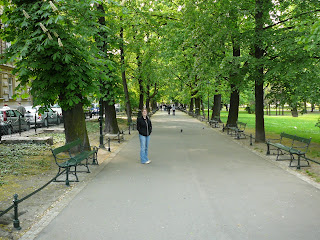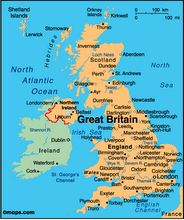 Saturday
Saturday
The down-side to extremely low airfares by flying Ryanair is that you usually have to be at Stansted airport by around 4.30am. So we were a little out of it when our cab picked us up at 3.45am. However, Ryanair outdid themselves - there were no delays or dramas and we arrived in Krakow on time at 9.15am.
Krakow is the third largest city in Poland, with a population of almost 800,000. Situated on the Vistula River in southern Poland, the city dates back to the 7th century. It was the capital city of Poland from 1038 to 1596. Krakow has traditionally been the centre of Polish scientific, cultural and artistic life and it is a major tourist destination, attracting around seven million visitors a year.
Krakow was one of the few Polish cities to be saved from major destruction during many wars which devastated the country. Left virtually untouched by WWII, the city has a historic centre with buildings ranging from Romanesque to Baroque. The uniqueness of the small Old Town centre, similar to Prague, led to a UNESCO world heritage site listing in 1978.
In the 14th century, King Kazimierz founded the second university in central Europe and further developed the city. Artists, revolutionary politicians (including Lenin), thinkers and writers were attracted to Krakow in the 19th and early 20th centuries. German occupation during WWII saw the Jewish community disappear and many of Krakow's intellectuals arrested. The subsequent communist period was not good to Krakow, mainly due to pollution from the Nowa Huta steelworks factory, which was built in an attempt to break the city's intellectual and religious traditions. In 1978, the then archbishop of Krakow, Karol Wojtyla, was elected Pope John Paul II.
It was very easy to find our way around Krakow - the city centre is very small and there are plenty of landmarks to help get your bearings. After dropping our bags at the hotel, we set off on foot to explore the Old Town. The heart of Krakow is the enormous Main Market Square, which dates back to the 13th century and measures 200m by 200m, making it the largest medieval square in Europe. The main landmarks in the square are Church of St Mary, Cloth Hall and the Town Hall Tower.
We sat outside one of the dozens of cafes and had a toasted sandwich and chocolate croissant for brunch, while we watched the throngs of Poles and tourists go about their business, as well as the old-fashioned horse and carts parading tourists around the Old Town. We were blessed with beautiful sunny weather the entire weekend and it was so nice sitting in the sun looking out at the beautiful old square.
From the square we walked down Grodzka, one of the main shopping streets, where there were a lot of gelato shops, towards Wawel Hill. Wawel is a symbolic place of great significance for all Polish people. The Royal Castle and the Cathedral are situated on the Hill.
Wawel Hill was inhabited by the Vistulan people in ancient times. The settlement came to prominence during the reigns of Boleslaw the Brave and Kazimierz the Restorer, the latter made Wawel the seat of his political power. From the 14th century onwards, the royal residence and a new cathedral were built. The last rulers of the Jagiellonian dynasty transformed the Gothic castle into one of the most magnificent Renaissance royal residences in central Europe.
Unfortunately the ticketing system for the Wawel Royal Castle does not match the magnificent buildings. We queued for around 45 minutes, only to find out when we got to the front of the line that tickets for some of the exhibitions in the castle were already sold out (they allow limited numbers of people through each exhibition per day), while the tickets we could still buy for other exhibitions allowed entry only at 4pm - three and a half hours away. We were rather disappointed and decided to skip the royal castle and head for the cathedral. Note for anyone going to Krakow, try to buy tickets for the royal castle in advance online or get there first thing in the morning before any exhibitions have sold out.
The queue for the Cathedral was much shorter and we got in there no worries, with audio guides in hand! The Cathedral at Wawel is similar to Westminster Abbey in London (although much smaller), in that it is so strongly associated with the history of Krakow and the whole of Poland. The existing building is the third to have been built on the site. The Cathedral was built by Wladyslaw the Short to house the relics of St Stanislaw, who was much venerated by the Poles. Many chapels dating from different periods adjoin the aisles. These chapels, many of which have been remodelled, contribute to the unique and picturesque exterior of the Cathedral.
The Cathedral was the traditional coronation site of Polish monarchs, even after the capital was moved to Warsaw in 1596. There are also many Polish monarchs and their families, bishops, noteworthy politicians and celebrated writers and poets buried in the Cathedral. It is also the cathedral of the archdiocese of Krakow. Pope John Paul II offered his first mass as a priest in the crypt of the Cathedral in 1946 and later, as Pope, considered being buried there.
We enjoyed the audio guide tour of the Cathedral - it was informative and also a well-timed tour, taking less than an hour despite the big crowds. We climbed the Zygmunt Tower, which houses the Zygmunt bell. The bell was cast in 1520 and weighs nearly 11 tonnes, making it the largest bell in Poland. The bell was used continuously from 1521 to 2000 but now is only used on special occasions, such as the election of a new pope. Although it was very narrow and pokey climbing the tower, there were great views across the city from the top, so it was well worth the effort!
Back down in the Old Town, we checked out a few shops. By this stage the market square was packed full of people and there were loads of live entertainers and buskers. We went into Cloth Hall, which sits in the middle of the square to hunt for some souvenirs. The Cloth Hall originated from a covered market centuries ago. It now houses the Gallery of 19th century Polish Paintings as well as dozens of market stalls selling a variety of souvenirs. Megan found a magnet to add to her growing collection!
From Cloth Hall we left the square and walked down another busy shopping street, Florianska, to the magnificent St Florian's Gate at the end of the street. From 1285, fortifications around the Old Town of Krakow were gradually developed, finally consisting of outer and inner moated walls, 47 towers and eight fortified gates that led into the city. With the introduction of artillery, the defence system became redundant and the fortifications fell into disrepair by the end of the 18th century. The walls were dismantled and later replaced by the Planty gardens, which now run almost all the way around the outside of the Old Town. St Florian's Gate and a small section of the adjoining walls have been saved (see photo below).
We grabbed a Coke and sat in the shade of the trees in the beautiful Planty gardens to rest our tired legs. Then we returned to the market square and checked out the Church of St Mary. St Mary's is a massive Gothic church that dominates the main market square. It was rebuilt in the 14th century and it stands at 80m high, with two asymmetric towers at the front.
On every hour, a trumpet signal — called the "heynal" — is played from the top of the taller of St. Mary's two towers. The plaintive tune breaks off in mid-stream, to commemorate the famous 13th century trumpeter, who was shot in the throat while sounding the alarm before the Mongol attack on the city.
We were very impressed with the church - it is decorated from the floor right up to the ceiling with magnificent sculptures, works of art, carvings and painted walls. It would easily be the most decorated church we have seen. It is particularly famous for its wooden alterpiece (11m long and 12m high), carved by Veit Stoss between 1477 and 1489.
After our church visit, we sat in the evening sun in the market square and enjoyed the live music from the buskers and the lively atmosphere of the square. Then we returned to the hotel to freshen up before dinner. We had done our research before heading out and we went to a bar called CK Browar. When we eventually found it, it was worth the effort. It is situated in a cellar deep under the Old Town. While it serves very good traditional Polish food, it is the beer that brings the crowds in. It brews its own beer on the premises and if you are feeling particularly thirsty, you can order beer in a tall pipe that the staff attach to your table and you pour the beer from the pipe into your glass by its little tap at the bottom. You can order a 3.3l or 5l beer pipe - to be shared amongst a group obviously. While we did not take on a pipe, we did enjoy the local brew and the rowdy atmosphere in the pub - a must for anyone travelling to Krakow!
From there we went to a restaurant called Chlopskie Jadlo, just off the market square for some traditional Polish food. The decor was a little strange and they were not serving any alcohol for some reason, but the food was good. We tried pierogi, which are a Polish favourite. Pierogi are dumplings with any one of a variety of different fillings such as cheese, mince meat, wild mushrooms and cabbage. These were quite nice, but we weren't so keen on the cabbage ones - they had a very sharp taste. We also had chicken schnitzel and cabbage leaf stuffed with mince and rice, which were both great. Then we continued our very Polish evening by tasting a local vodka at a bar in the market square. It was a nice way to end a very enjoyable day exploring a beautiful city!

Market
Square
Wawel
Royal
Castle
Wawel
Cathedral
Us on
Wawel
Hill
Cloth
Hall
Market
stalls in
Cloth
Hall
Church of Saints
Peter and Paul
Statues of
the Apostles
Florianska
St Florian's
Gate
Megan in
Planty
gardens
Church of
St Mary -
market square
High alter
in St Mary's
Megs at
CK Browar -
see beer pipe
behind her
Horse and
cart rides

St Mary's
at sunset

Market
square by
night

Bear
 Saturday
Saturday





















No comments:
Post a Comment